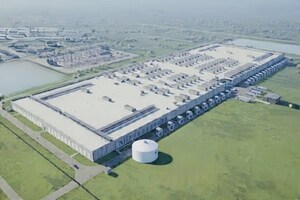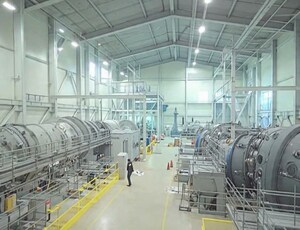
PITTSBURGH, Nov. 4, 2025 /PRNewswire/ -- As AI continues to expand, hyper-scale data centers are emerging all across the United States. These massive facilities are certainly driving the digital economy, but while public attention mostly focuses on carbon emissions and renewable energy, a quieter crisis is quickly unfolding: fresh water.
The Fresh Water Cost of Power
The energy demands of AI infrastructure are growing faster than clean energy can scale. Wind, solar, and nuclear offer lower fresh water footprints, but none can meet the immediate rapid expansion of AI workloads. As a result, most AI data centers remain dependent on fossil fuel power, which consumes large volumes of fresh water.
Although the move to closed loop AI data center cooling systems has reduced direct fresh water withdrawals by recycling internal supply, they require 10 to 40 percent more electricity to operate. This additional energy demand shifts the fresh water burden upstream to the power plant, thereby relocating rather than resolving the environmental impact for local communities. It is also another factor driving consumer electricity prices much higher.
The Closed Loop Illusion
Closed loop cooling is definitely a meaningful improvement over traditional evaporative systems in hyper-scale AI data centers. It minimizes local fresh water consumption and is often promoted as a sustainable solution. Yet, the reality is more complex.
These systems rely on pumps, heat exchangers, and control mechanisms that draw substantial power. In most regions, that power comes from thermoelectric plants, which are among the largest consumers of fresh water in the country. The result is a hidden transfer of environmental cost, masked by clean technology branding, yet still absorbed by surrounding communities.
From Wet Cooling to Hybrid & Dry Cooling
Hybrid and dry cooling systems for natural gas turbine power plants are often touted as water-saving alternatives, but they are still far from waterless. Hybrid configurations still consume 50 to 150 gallons of water per MWh and dry cooling, while certainly minimizing fresh water use to 5 to 30 gallons of water per MWh, demands, much like closed loop cooling, significantly more electricity to operate. This added power burden exacerbates already rising electricity rates, especially in regions where AI data centers compete with residential and industrial users for grid capacity. The shift from wet to hybrid or dry cooling may reduce initial visible water withdrawals, but it intensifies upstream energy demand, deepening the hidden water footprint and inflating electricity costs for everyday consumers.
Gneuton Shifts AI Data Centers From Community Burden to Benefit
Gneuton offers a transformative alternative right now.
By capturing the waste heat from gas turbine powered AI data centers or from their gas turbine backup generators, Gneuton's patented zero energy thermal distillation process purifies wastewater into clean, stable fresh water. This includes brackish, industrial, and produced sources. The system requires no additional electricity and integrates seamlessly with existing AI infrastructure. "Closed loop cooling may reduce local water withdrawals, but it doesn't erase the upstream cost," said Brad Martineau, CEO of Gneuton. "Every extra kilowatt pulled to run these systems deepens the water footprint at the power plant, and also drives up electricity prices for everyone. At Gneuton, we believe sustainability means more than shifting burdens. It means turning infrastructure into assets that serve both intelligence and community."
This breakthrough enables hyperscale AI data centers to continue using high performance, water intensive cooling loops that are far more efficient than closed loop systems, but without increasing net fresh water withdrawals. At the same time, Gneuton's technology allows new gas turbine power plants that are being built to deploy traditional wet cooling, which delivers superior thermal efficiency. By generating a new on site source of purified fresh water, Gneuton effectively closes the loop for both the AI data center and the gas turbine power plant, thereby transforming them from environmental burdens into regional water assets.
The Sustainable and Ethical Path Forward
AI's energy appetite continues to outpace clean generation. Renewable sources are promising but not yet sufficient. Nuclear remains reliable but slow to deploy. In the meantime, AI runs on a mix of fossil fuels and recycled water, with the true environmental costs often obscured.
Sustainability requires more than efficiency. It demands innovation that transforms infrastructure into real community assets. While closed loop cooling reduces local fresh water withdrawals, it still relies on energy intensive systems that shift the environmental burden upstream. The true opportunity lies in reimagining AI data centers and gas turbine power plants as integrated platforms not only for powering intelligence, but for producing fresh water. Gneuton's technology makes this possible by really closing the loop and turning high performance energy systems into regional sources of resilience.
Gneuton is building that future today.
About Gneuton
Gneuton is the world's first regenerative AI infrastructure company, transforming gas turbine exhaust into purified water for AI data centers and industrial ecosystems. Gneuton combines advanced thermodynamics, ecological science, and ethical AI to deliver infrastructure that replenishes what it consumes.
To learn more or schedule a briefing, visit Gneuton.com.
Statements regarding future plans or outcomes reflect current expectations and are subject to change based on operational, regulatory, and environmental factors.
Media Contact:
Brad Martineau
CEO, Gneuton
Email: Brad @Gneuton.com
Phone: (724) 840-3672
Website: Gneuton.com
SOURCE Gneuton








Share this article